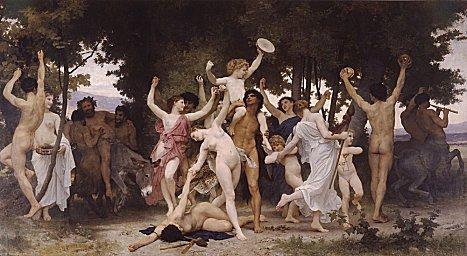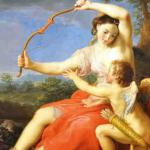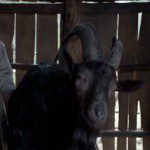Even though I believe my spiritual practice is a rather new thing by the standards of religion, it has ancient roots. The deities I worship are centuries old, existing before Christianity, and my ritual system has its origins in at least the Medieval Period (and I’m of the opinion that it’s even older than that). But my Witchcraft, and the deities that go along with it, did not descend to me in an unbroken chain. This is especially true with a construct such as The Horned God.
Twenty years ago when I began taking my first baby-steps as a Witchling I believed that the Horned God was a truly ancient figure. If you are familiar with the books and lore of that era I’m sure you know how the story goes. In that particular tale the Horned God was the first male deity, and every culture had their own version of Him. He was the god of fertility and the fields, and often depicted with an erect phallus to designate that aspect of his worship. Eventually his worship broke down with the coming (and winning) of Christianity and he was turned into their Devil. In some versions of the tale a corrupted form of the Horned God was worshipped as the Christian Devil by Witches who kept to the “Old Ways” after the triumph of the Catholic Church.
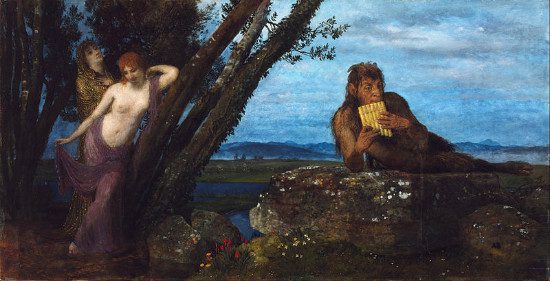
It’s a lovely story, but it’s not a true one. The Horned God is a modern construct, not an ancient one, and while it’s true that he does have a bit of the Devil in His DNA, that too is a modern addition. The ancients didn’t have a universal Horned God, what they had were various horned (and antlered) gods who served a variety of needs. These gods were all quite different as well, and sometimes don’t sync up in anyway other than having ornamentation on the top of their heads.
More About the Horned God on Raise the Horns:
A Complete History of the god Pan
Faces of the Horned God: Herne the Hunter
Kokopelli: Fertility God of the American Southwest
The Veil and the Dread Lord of Shadows
One Day I’ll Finally Post my Cernunnos Article
Cernunnos and Pan are probably the two most popular “horned gods” in Modern Paganism and they couldn’t be more different. Pan was a god of wild spaces, separation from civilization, masturbation, shepherds, goats, lust, and rustic music. Cernunnos was never depicted with an erect phallus, and was a god of hunting and wealth. He also had antlers on his head which are completely different from horns. In other words the two gods have nothing in common other than a superficial resemblance.
Horned and antlered gods were never as popular as we’ve been lead to believe either. Pan was always solidly a “B” god outside of his native Arcadia, favored by some, but lacking the massive cult that would define many of the most popular religious movements of the Roman Empire. Worship of Cernunnos was even less widespread, in fact his name only appears once in the archeological record. The cults of Dionysus (including Orphic religion) were quite popular, but Dionysus was rarely depicted as horned (or antlered).
In most tellings of the classic Horned God story he is said to descend from a “root” deity. Though we’ve never been able to trace the gods back to one place of origin there were cultures who spread their ideas far and wide. The most influential of those groups (especially when it comes to Modern Paganism) were the Indo-Europeans.* The people we today call Indo-Europeans worshipped many different deities and through linguistics there are things we can infer about those deities and the religion(s) that revolved around them.
Indo-European gods were generally beings of place and/or things that could be seen and/or touched. The Indo-Europeans had Sky Gods, Sun Gods (and a few goddesses too!), Sea Gods, Earth Mothers, Moon Goddesses, etc. What they didn’t have was a deity type that we might think of us a traditional “Horned God.” Pan might have shared an Indo-European root with the Vedic Pusan, but that root didn’t contain the lusty Pan we know today, but Pan as shepherd and guardian of flocks. In other words, Pan’s ancient origins can’t be tied to a god of the natural world, but to a god of animal husbandry. The only other god Pan can be definitively linked to in terms of origins is his father Hermes. Notably absent are Dionysus, Ing, Cernunnos, the Hebrew Lucifer, and literally everyone else.
Ancient pagans didn’t have a Horned God, they had horned gods, and after Christianity became the dominant (and often the only) religion in Europe they ceased to be worshipped. Certainly the “gods of the old religion” can turn into “the devils of the new,” but images of the Christian Devil are extremely varied. Some of them are goat-like (and by extension Pan-like) but there are many more that are not. Representations of the Devil as Pan-like actually spiked in the Nineteenth Century with the establishment and popularity of His literary cult. It’s true that goats were often associated with the Devil, but this is more likely due to just how difficult it is to control a goat than the god Pan. Besides, dogs and cats were also associated with Old Scratch and those have nothing to do with any horned or antlered got that I’m aware of.
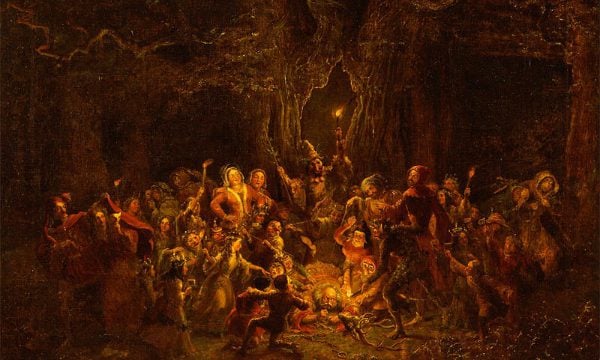
The Horned God as an archetype** (a bigger god or idea made up of several smaller ones) is a 20th Century one, made famous by Margaret Murray in her book The God of the Witches (1933). In God of the Witches Murray links a whole host of disparate ideas and deities-Pan, Cernunnos, Robin Hood, Herne, Dionysus, Ancient Cave Paintings-and turns them into one bigger thing-The Horned God. The problem with Murray’s thesis is that these things are impossible to link together in any rational way. They are all separated by huge chasms of time and place, not to mention the deities she mentioned were often worshipped in entirely different ways.
Murray’s descriptions of Witchcraft (and its attendant Horned God) are also rather dubious to begin with. The “Murray Thesis***” (which argues that an organized Witch Religion existed side-by-side with Christianity up into the present age) has been dismissed by the majority of scholars. Even if there was an organized witch-religion in the time frame Murray suggests, it’s still separated from pagan antiquity and the worship of Pan and his brethren by a period of 1000 years. When magical societies emerge in the historical record they often lack the Horned God Murray says should be there and generally exist in opposition to Witchcraft.
Because Murray links her God-of-the-Witches to the Christian Devil, our bigger, modern Horned God contains vestiges of the fanciful Medieval/Renaissance Satan. So when someone argues that the Devil is part of the Horned God’s past they aren’t wrong per say, but that association is not ancient and has nothing to do with Witch trials or gods such as Pan or Cernunnos slowly being slowly absorbed by a Christian Devil.
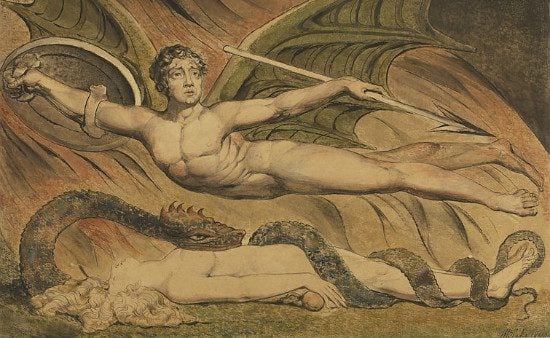
If the composite Horned God is relatively new, is it still valid? Of course it is, deity works in mysterious ways and perhaps this larger Horned God exists today because we need him too. Do some Modern Witches worship the Devil and see him rather prominently in today’s Horned God? Certainly, the Devil has always been a complex piece of mythology, just as likely to serve as the mis-understood light-bringer as the root source of all evil. (Go back and read your Bible if you are concerned about it, evil existed way before Lucifer was thrown out of heaven in that mythology.)
But the Horned God didn’t survive Christianization because there was no Horned God to survive it. The idea didn’t exist then and the figure that emerges from the Witch trials is one of delusion and torture, not history. Like the Witchcraft he’s often honored in, Old Hornie is a product of the Twentieth Century. Was he influenced by what came before? Certainly, but for most of history there have been only horned gods, not a Horned God.
*The term Indo-European refers to language and not race. The Indo-Europeans spread their language and culture from one end of Eurasia to the other. As a result many of the most common pantheons honored by Pagan-types today (Greek, Celtic, Norse, Hindu) emerged from Indo-European roots. Gods such as Odin and Zeus most likely had a common ancestor in the pantheon of the Indo-Europeans.
**And yes when it comes to the classic definition of archetype I’m using that word wrong, but I don’t care.
***Murray “stole” many of her ideas from French writer Jules Michelet, whose ideas have also been dismissed over the last 150 years by most scholars. In fact, Michelet’s ideas were never seen as serious in his native France.
Stay in touch! Like Patheos Pagan on Facebook:


